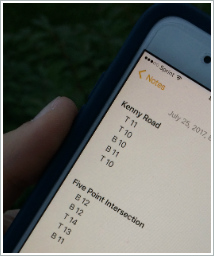
When it comes to working smart, a little bit of research can go a long way.
You don’t have to be a full-on scientist by any means. But if you want to improve how work gets done, you’ll want to conduct the occasional inquiry.
It can be simple, informal, even fun. And it’s likely to be illuminating.
My 19-year-old daughter is working as a math tutor this summer. The learning center is across town, and she can take two different routes to get there.
Wanting to minimize her drive, she put on her inquiry cap. She started taking the different routes – and used her phone to record the number of minutes for each trip. (You can see some of her data in the photo.)
After a couple weeks of testing, she conclusively knew the fastest route.
How can this inquisitive approach help you at work?
Let’s say your work group gets needed information from an incoming form – but half the time the information is incomplete or inaccurate.
So you and your colleagues construct a simple test. As the forms arrive, each of you keeps a running tally of the information fields that have errors. After two weeks, you combine your check-sheet data to create a single Pareto chart that reveals which fields are causing the most problems.
All of you had your theories. Now you have data and a convincing picture.
You know where to focus in order to improve the quality of incoming information.
None of the above requires you to be the next Marie Curie or Isaac Newton.
Simply be curious. Seek out data and facts. Organize the information so you can draw conclusions. Then use the insights to power improvement.




